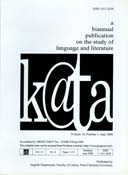Packaging Consumption: Stylistic Devices and Persuasive Functions of American and Indonesian Advertising Slogans
Abstract
This study discusses the significance of style in creating indelible and iconic slogans that endures time. In this study, by using qualitative content analysis, I examine the stylistic devices of the ten American and Indonesian food and beverages slogans in order to find out their persuasive functions. In my analysis, I utilize three levels of stylistic analysis: phonological, lexical, and grammatical. My findings show that the most significantly used devices are the devices at the lexical level, then followed by those at grammatical and phonological level. My findings also show five recurring usages of the stylistic devices that help invoke the buying motives within the customers, namely idioms and proverbs, personification, humor, emotional appeal, and imagery. The usages serve a persuasive function by aided in influencing customers into purchasing the goods offered by the brand.
Downloads
References
Benazir, A. (2014). Discourse Analysis of the English Language in the Select Advertisements of The Hindu. Shodhgaga: reservoir of Indian theses. Retrieved from http://hdl.handle.net/10603/97765
Crystal, D., and Davy, D. (1969). Investigating English Style. New York: Routledge.
Damasio, A. (2005). Descartes Error: Emotion, Reason, and The Human Brain. London: Penguin Books.
Johanssen, K. (2016). The Language of Advertising: Powerful, innovative and environmental?. New perspectives on sustainability, no.2, p.6-27. Retrieved from https://www.google.com/url?sa=t&rct=j&q=&esrc=s&source=web&cd=2&cad=rja&uact=8&ved=0ahUKEwji4-Pi-qjcAhXNfn0KHaPZD0gQFgg1MAE&url=http%3A%2F%2Fojs.udg.edu%2Findex.php%2Fperspectives%2Farticle%2Fdownload%2F120%2F162&usg=AOvVaw1Q6lh03J14H0BprQ2QH0OF
Krippendorff, K. (2004). Content analysis: An introduction to its methodology (2nd ed.). Thousand Oaks, CA: Sage.
Leech, G. (2008). Language and Literature: Style and Foregrounding. London: Longman.
Moriarty, S., Mitchell, D., Wells, W., et al. (2012). Advertising: Principles and Practice 3rd Edition. Melbourne: Pearson.
O'guinn, T. C., Allen, C. T., & Semenik, R. J. (2011). Advertising and integrated brand promotion. South- Western Pub.
Robert, E. (2013). Language of advertising: a study of Nigeria's Nation Newspaper and Newswatch Magazine. Journal of Education and Learning, 2(3):61-70.
Simpson, P. (2004). Stylistics: A Resource Book for Students. London/New York, Routledge.

This work is licensed under a Creative Commons Attribution 4.0 International License.
![]() This work is licensed under a Creative Commons Attribution License
This work is licensed under a Creative Commons Attribution License




.png)
.png)

.png)












